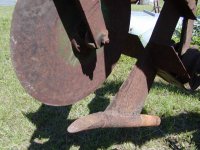I designed and put in my own system using Schedule-40 PVC trenched-in for the main pressure line and black poly pulled-in for the zone branches.
I estimated that about 1/2 the cost of the system would be in parts, and 1/2 in labor. Since my labor is billed at $0.00 per hour, I did all the labor myself, cutting the cost of the system in about half.
Nice thing about trenching in the main line is that there was little or no digging to put in the zone valve boxes. It was also easy to toss in all the wiring into the trench. I used a Toro Tracked-Dingo with a trenching attachment and it worked great - plenty of HP to chug through the hard clay I have.
I pulled the branch line poly by attaching it to a subsoiler. I attached it by folding the poly over and tying it to the base of subsoiler with a few turns of bailing wire. I cut off the kinked end of the pipe after the pull. It ripped up the yard some, but only took a few minutes per run. Most of that time was spent dealing with digging a pilot hole and attaching the poly to the subsoiler for each run.
It wasn't the cleanest way to pull the pipe, but I already had the tractor and the subsoiler. To repair the surface where the subsoiler pulled up the dirt a bit, I just drove over it a few times with the tractor wheel. I did all the work before laying the sod, so I didn't much care how much I ripped up the yard.
If the yard was already sodded, I would get a vibratory plow and pull all of the pipe that way.
Toro has a design guide you can download from their site. They also have a free design service for do-it-your-selfers.
One thing I neglected in my design was the position of some of the trees on my yard. I ended up having to add a couple of heads to cover some spots that were "shadowed" by large trees close to the originally designed head placements.
My system was Toro-centric because my father and I both worked for them, but I would recommend against their controllers.
However, the Toro heads have a very good reputation. They have two lines - the commercial stuff and the consumer stuff you can buy at Home Depot. I put in the commercial stuff (model 700's and 600's) since the commercial heads have built-in filtration and I am pumping my water from a lake. Some of the later-added heads mentoined above were the simple spray type consumer grade from Home Depot and those have worked fine as well.
My system pumps from the lake at the bottom of my yard and pushes the water up 30' of elevation. I used a 1.5 HP pump. I designed for 15gpm at 45 psi at the bottom of the hill and 30 psi at the top. The zones were designed based on seperating shady vs. sunny parts of the yard as well as those zones that are on the top of the slope vs. the bottom.
The rule of thumb for even coverage is to make sure every head can fully reach its adjoining head. In other words, every square foot of grass is watered by at least two heads. When calculating the coverage radius, be sure and use the radius for the lowest pressure shown on the chart to ensure the system has a margin of overdesign.
I used 6 gpm nozzles for the full circle heads, 3 gpm nozzles for the 180-degree heads, and 1.5 gpm nozzles for the 90-degree heads.
I don't have any automatic drains in my system, but the PVC runs straight up the hill and can be gravity drained at the pump. The branch lines run across the hill and need to be blown out in the fall. The pump itself also needs to be drained and its suction line pulled from the lake before freezing weather is expected.
A buddy of mine who installs systems for a living took a look at my design and the only thing he would add would be a filter to prevent any sand/gunk from the lake from getting into the valves and heads.
One really cool feature that some controllers have (mine does not) is the ability to be remote-controlled. It would be very handy to be able to turn on a zone to check and adjust heads without running back and forth to the controller (and tracking mud into the garage) each time.
- Rick
